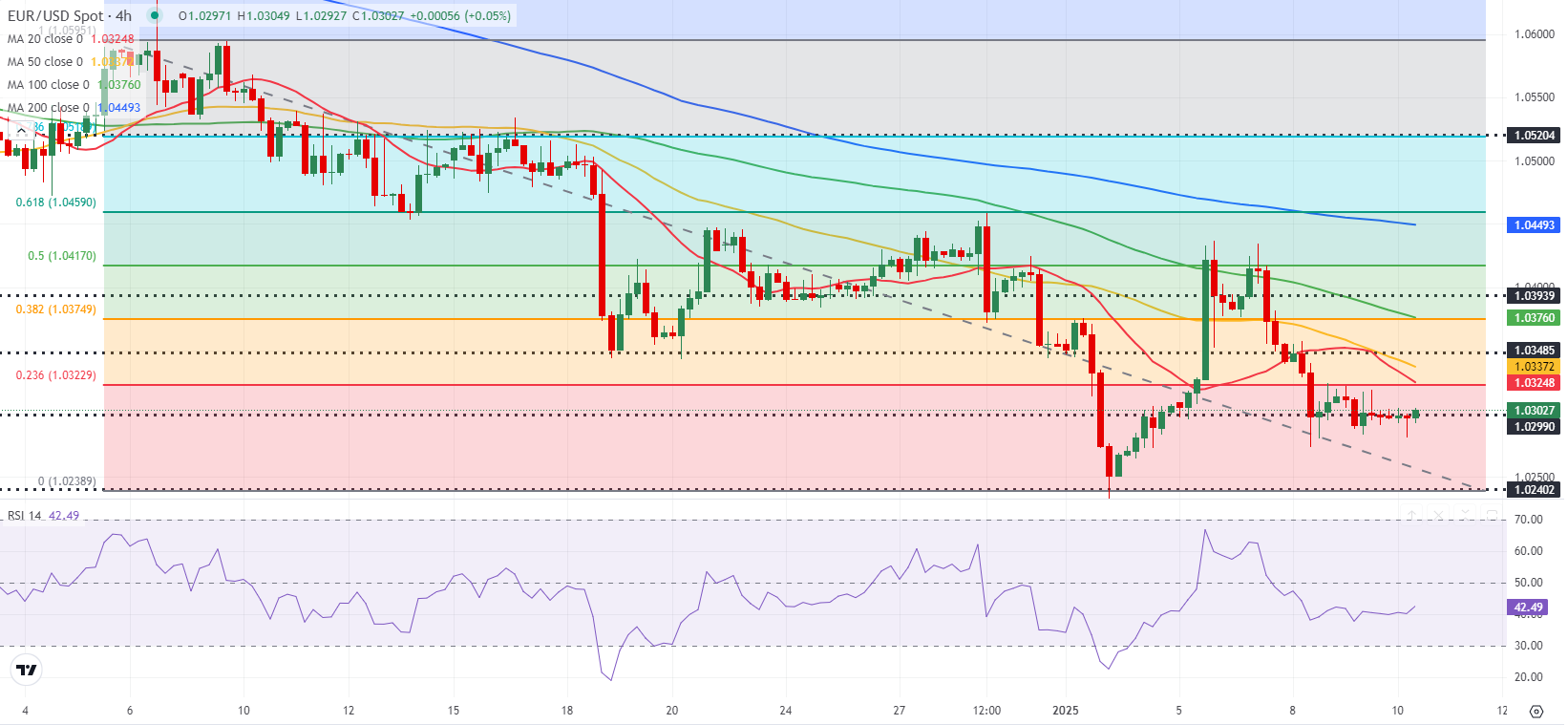- EUR/USD trades in a tight range at around 1.0300 in the European morning.
- The cautious market stance doesn't allow the pair to stage a rebound.
- December employment data from the US could trigger the next big action in the pair.
EUR/USD holds steady near 1.0300 in the early European session on Friday after closing in negative territory for the third consecutive day on Thursday. The pair remains technically bearish in the near term as focus shifts to labor market data from the US.
Euro PRICE This week
The table below shows the percentage change of Euro (EUR) against listed major currencies this week. Euro was the weakest against the Canadian Dollar.
| USD | EUR | GBP | JPY | CAD | AUD | NZD | CHF | |
|---|---|---|---|---|---|---|---|---|
| USD | 0.06% | 1.04% | 0.74% | -0.36% | 0.41% | 0.50% | 0.32% | |
| EUR | -0.06% | 0.96% | 0.65% | -0.37% | 0.38% | 0.48% | 0.30% | |
| GBP | -1.04% | -0.96% | -0.31% | -1.32% | -0.57% | -0.48% | -0.66% | |
| JPY | -0.74% | -0.65% | 0.31% | -1.09% | -0.31% | -0.20% | -0.19% | |
| CAD | 0.36% | 0.37% | 1.32% | 1.09% | 0.70% | 0.82% | 0.66% | |
| AUD | -0.41% | -0.38% | 0.57% | 0.31% | -0.70% | 0.10% | -0.09% | |
| NZD | -0.50% | -0.48% | 0.48% | 0.20% | -0.82% | -0.10% | -0.18% | |
| CHF | -0.32% | -0.30% | 0.66% | 0.19% | -0.66% | 0.09% | 0.18% |
The heat map shows percentage changes of major currencies against each other. The base currency is picked from the left column, while the quote currency is picked from the top row. For example, if you pick the Euro from the left column and move along the horizontal line to the US Dollar, the percentage change displayed in the box will represent EUR (base)/USD (quote).
With US stock markets remaining closed and bond markets closing early in observance of a national day of mourning to honor the death of former President Jimmy Carter, the market action turned subdued on Thursday. Early Friday, US stock index futures lose between 0.1% and 0.4%, reflecting a cautious market stance, which makes it difficult for EUR/USD to stage a rebound.
Later in the day, the US Bureau of Labor Statistics will publish the December employment report. Markets expect Nonfarm Payrolls to rise by 160,000 following November's 227,000 increase. The Unemployment Rate is forecast to remain unchanged at 4.2%.
An NFP reading above 200,000 could boost the USD heading into the weekend and force EUR/USD to stretch lower. On the other hand, a disappointing print below 150,000 could have the opposite impact on the pair's action. In case the headline NFP arrives near the market consensus, the change in the Unemployment Rate could drive the USD's valuation, with an unexpected rise hurting the currency and vice versa.
EUR/USD Technical Analysis
The Relative Strength Index moves sideways below 50 and EUR/USD remains below the 20 and the 50-period Simple Moving Averages (SMA) on the 4-hour chart, highlighting buyers' hesitancy.
In case EUR/USD confirms 1.0300 (static level, round level) as resistance, 1.0240 (static level, end point of the latest downtrend) could be seen as next support before 1.0200 (static level, round level). If the pair manages to stabilize above 1.0300, 1.0325 (Fibonacci 23.6% retracement of the latest downtrend, 20-period SMA) and 1.0375 (100-period SMA, Fibonacci 38.2% retracement) could be seen as next resistance levels.
Nonfarm Payrolls FAQs
Nonfarm Payrolls (NFP) are part of the US Bureau of Labor Statistics monthly jobs report. The Nonfarm Payrolls component specifically measures the change in the number of people employed in the US during the previous month, excluding the farming industry.
The Nonfarm Payrolls figure can influence the decisions of the Federal Reserve by providing a measure of how successfully the Fed is meeting its mandate of fostering full employment and 2% inflation. A relatively high NFP figure means more people are in employment, earning more money and therefore probably spending more. A relatively low Nonfarm Payrolls’ result, on the either hand, could mean people are struggling to find work. The Fed will typically raise interest rates to combat high inflation triggered by low unemployment, and lower them to stimulate a stagnant labor market.
Nonfarm Payrolls generally have a positive correlation with the US Dollar. This means when payrolls’ figures come out higher-than-expected the USD tends to rally and vice versa when they are lower. NFPs influence the US Dollar by virtue of their impact on inflation, monetary policy expectations and interest rates. A higher NFP usually means the Federal Reserve will be more tight in its monetary policy, supporting the USD.
Nonfarm Payrolls are generally negatively-correlated with the price of Gold. This means a higher-than-expected payrolls’ figure will have a depressing effect on the Gold price and vice versa. Higher NFP generally has a positive effect on the value of the USD, and like most major commodities Gold is priced in US Dollars. If the USD gains in value, therefore, it requires less Dollars to buy an ounce of Gold. Also, higher interest rates (typically helped higher NFPs) also lessen the attractiveness of Gold as an investment compared to staying in cash, where the money will at least earn interest.
Nonfarm Payrolls is only one component within a bigger jobs report and it can be overshadowed by the other components. At times, when NFP come out higher-than-forecast, but the Average Weekly Earnings is lower than expected, the market has ignored the potentially inflationary effect of the headline result and interpreted the fall in earnings as deflationary. The Participation Rate and the Average Weekly Hours components can also influence the market reaction, but only in seldom events like the “Great Resignation” or the Global Financial Crisis.
Information on these pages contains forward-looking statements that involve risks and uncertainties. Markets and instruments profiled on this page are for informational purposes only and should not in any way come across as a recommendation to buy or sell in these assets. You should do your own thorough research before making any investment decisions. FXStreet does not in any way guarantee that this information is free from mistakes, errors, or material misstatements. It also does not guarantee that this information is of a timely nature. Investing in Open Markets involves a great deal of risk, including the loss of all or a portion of your investment, as well as emotional distress. All risks, losses and costs associated with investing, including total loss of principal, are your responsibility. The views and opinions expressed in this article are those of the authors and do not necessarily reflect the official policy or position of FXStreet nor its advertisers. The author will not be held responsible for information that is found at the end of links posted on this page.
If not otherwise explicitly mentioned in the body of the article, at the time of writing, the author has no position in any stock mentioned in this article and no business relationship with any company mentioned. The author has not received compensation for writing this article, other than from FXStreet.
FXStreet and the author do not provide personalized recommendations. The author makes no representations as to the accuracy, completeness, or suitability of this information. FXStreet and the author will not be liable for any errors, omissions or any losses, injuries or damages arising from this information and its display or use. Errors and omissions excepted.
The author and FXStreet are not registered investment advisors and nothing in this article is intended to be investment advice.
Recommended Content
Editors’ Picks

EUR/USD holds near 1.0300 as traders await US NFP
EUR/USD trades in a tight channel at around 1.0300 in the European session on Friday. However, concerns over US President-elect Trump's policies and hawkish Fed expectations keep the US Dollar afloat ahead of the Nonfarm Payrolls data, capping the pair's upside.

GBP/USD struggles to stay above 1.2300, eyes on US jobs report
GBP/USD finds it difficult to gather recovery momentum after rising above 1.2300 earlier in the day. The pair remains vulnerable amid persistent US Dollar strength and the UK bond market turmoil. The focus now shifts to the US labor market data for fresh directives.

Gold climbs to fresh multi-week high above $2,680 ahead of US NFP
Gold price (XAU/USD) gains some follow-through positive traction for the fourth consecutive day and trades at its highest level in nearly a month above $2,680. Market focus shifts to US labor market data, which will feature Nonfarm Payrolls and wage inflation figures.

Nonfarm Payrolls forecast: US December job gains set to decline sharply from November
US Nonfarm Payrolls are expected to rise by 160K in December after jumping by 227K in November. US jobs data is set to rock the US Dollar after hawkish Fed Minutes published on Wednesday.

How to trade NFP, one of the most volatile events Premium
NFP is the acronym for Nonfarm Payrolls, arguably the most important economic data release in the world. The indicator, which provides a comprehensive snapshot of the health of the US labor market, is typically published on the first Friday of each month.

Best Forex Brokers with Low Spreads
VERIFIED Low spreads are crucial for reducing trading costs. Explore top Forex brokers offering competitive spreads and high leverage. Compare options for EUR/USD, GBP/USD, USD/JPY, and Gold.
